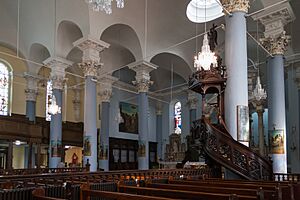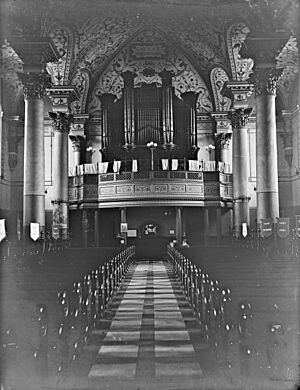Cathedral of the Most Holy Trinity, Waterford facts for kids
Quick facts for kids Cathedral of the Most Holy Trinity |
|
|---|---|
 |
|
| 52°15′41″N 7°06′40″W / 52.2614°N 7.11109°W | |
| Location | Barronstrand Street, Waterford, Ireland |
| Denomination | Roman Catholic |
| History | |
| Status | Cathedral |
| Consecrated | 1793 |
| Architecture | |
| Style | Classical |
| Completed | 1793 |
| Specifications | |
| Materials | Limestone |
| Administration | |
| Parish | Cathedral |
| Diocese | Waterford and Lismore |
| Province | Cashel and Emly |
The Cathedral of the Most Holy Trinity is a very important church for Roman Catholic people in Waterford City, Ireland. It's located on Barronstrand Street. This cathedral is special because it's the oldest Catholic cathedral in Ireland built after the Reformation, even before Catholics were given more rights in 1829.
History of the Cathedral
The cathedral was designed by an architect named John Roberts in 1793. It holds the special title of being the oldest Catholic cathedral in Ireland built after the Reformation. The building was overseen by Rev. Dean Thomas Hearn. John Roberts also designed another famous church in Waterford, Christ Church Cathedral, Waterford.
Before this grand cathedral, a smaller chapel, known as the 'Big Chapel', stood on the same spot. It was built in 1693 when laws against Catholics, called the Penal Laws, were very strict. This 'Big Chapel' replaced an even older place of worship, which was a converted store. That store was used after 1660, when Catholics had a bit more freedom.
The cathedral has been changed and made bigger many times over the years. It started as a square building, and later parts were added to both the east and west sides. In the early 1800s, the sanctuary (the area around the altar) was extended. In 1854, a new section called an apse was added, and a new altar was put in.
The cathedral's impressive William Hill & Sons organ was installed in 1858. Two side altars, one for Our Lady and one for St Joseph, were also added.
Later, Bishop John Power made some of the biggest changes. In 1881, he ordered a beautiful baldachin (a canopy over the altar) and a new altar. He also had the ceiling and walls decorated with many colours. In 1883, Bishop Power asked George Goldie to design the grand Baroque-style pulpit, the choir stalls, and the bishop's special chair, called a cathedra. These were all carved from oak in France.
The cathedral's beautiful stained glass windows were put in between 1883 and 1887. Most of them were made by Mayer of Munich. In the late 1800s, a new stone front was added to the west side of the building. Not everyone liked these changes at first, as some people thought the new decorations were too flashy or unnecessary.
More changes happened in the early 1900s, including updates to the organ area and the entrance. In the 1930s, the cathedral was redecorated. Steel rods were put between the columns to help monitor any movement, as the cathedral is built on marshy ground. You can still see signs of this movement on the north side of the main hall.
In 1977, the cathedral was updated again to fit new church practices. The choir stalls and bishop's chair were moved, and a new altar was installed so that Mass could be celebrated facing the people. This new altar includes carvings from another church, showing respect for history. In 1979, Waterford Crystal gave ten crystal chandeliers, making the cathedral even more beautiful. The floor was completely redone, and the sacristy (a room for priests) was changed between 1989 and 1992. The roof was also repaired in 2006.
Cathedral Organ
The cathedral's pipe organ was built in 1858 by William Hill & Sons of London. This was actually the third organ in the cathedral. The first one was built in 1773 for the old 'Big Chapel' and was likely moved to the new cathedral. That organ was later replaced by a smaller one in 1826.
The 1858 Hill organ was officially opened on August 29, 1858, with a famous organist named W.T. Best playing the first concert. This organ had three keyboards and 43 different sounds. It was powered by hand at first, using a system of levers.
In 1901, the Hill company updated the organ. They changed how the keys worked and added a new console (the part with the keys and stops). A large hydraulic system was installed to blow air into the pipes, which was later changed to electric power in the early 1900s. The organ was significantly rebuilt again in 1965, with more changes to its sound and structure.
Images for kids
See also
 In Spanish: Catedral de la Santísima Trinidad (Waterford) para niños
In Spanish: Catedral de la Santísima Trinidad (Waterford) para niños






